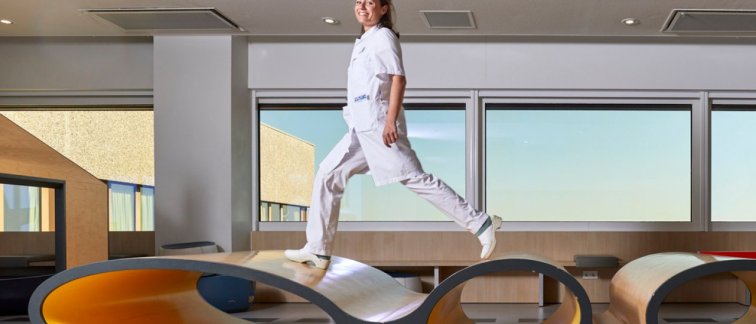substantially fewer hospital visits and extremely satisfied parents, says
pediatric surgeon in training Kelly Dreuning.
"Children with an inguinal hernia, you see a swelling in the groin and they go to the family doctor. He either refers them directly to a (pediatric) surgeon or - in twenty percent of the cases - first to another doctor, who then refers them to the surgeon. If it is an inguinal hernia, the child goes to the anesthesiologist. Before the operation, the anesthesiologist schedules another appointment to assess the child's health and any risks associated with anesthesia. The whole process can easily take three days. For the one-stop-shop procedure, the general practitioner refers the children to our special inguinal hernia clinic, where they are seen by the surgeon and the anesthesiologist one after the other. Parents can take a picture of the swelling in advance and upload it to a special website. Based on that photo and the parents' story, a surgeon makes the diagnosis. After the inguinal hernia clinic, the child is operated on and allowed to go home the same day."
Can you help all children in whom you suspect an inguinal hernia in this way?
For the time being, only those we can admit to the day treatment center. In the Emma Children's Hospital of Amsterdam UMC, we operate on about 250 children with an inguinal hernia every year. About a hundred of those end up in our fast track. Children under three months and those born prematurely have to stay overnight for observation. This is because of the possible risks associated with anesthesia in these children. Sometimes additional testing is required prior to surgery because of their history. As a result, these groups are not eligible for treatment in the one-stop shop.
A teaching hospital like ours is an excellent setting for the fast track. Congenital inguinal hernias - the child is born with a hole in the inguinal canal in which part of the intestines or abdominal fat is located - are especially apparent in infants. For anesthesia, therefore, you need a pediatric anesthesiologist. You don't have one in a general hospital. Amsterdam UMC has a "one-stop-shop day" every two weeks that consists solely of inguinal hernia operations. It was a logistical challenge to realize the concept, but the result is worth it!
This is the first time that such a pathway has been introduced for children. It shows that it can be done, as long as you prepare the children.
That preparation is everything, because a hospital visit is quite drastic for children. For example, they may suffer from nightmares or bedwetting after the operation. That is why we have developed various tools to prepare children at home. For the youngest children there is a coloring page. We have also made a video that shows what a day in the hospital looks like. And for the somewhat older children, we have developed an app together with the Hoi Dokter foundation: 'Dag groinbreuk'. This has been extensively tested and improved. The app provides all sorts of information about the course of the admission and who they might meet in the hospital. They can also 'walk' around the department and the operating room virtually. For parents, an accompanying guide is available with more detailed information. In this way they themselves determine what information they want to show their child and how long they want to dwell on an item. This works so well that the operating staff asked us what we had done with the children because they were so relaxed before the procedure.
What are the benefits of the one-stop-shop concept?
Because everything is scheduled on one day, parents don't have to take time off as often. Another advantage: the surgeon who does the inguinal hernia clinic in the morning is also the one who operates on the child. So there is only one attending physician. In addition, parents can choose their own surgery date, which gives them some control over their own schedule. The intention is that the course will lead to more direct referrals to the right specialist and therefore fewer visits to the hospital. In this way we hope to save more costs in the future. This concept can also be applied to other simple procedures. It is already possible to operate on navel ruptures (a hole in the abdominal wall near the navel) and water fractures in children in this way. Water ruptures only occur in boys; through a hole in the inguinal canal, fluid collects at the testicle. We are now working on a further expansion of the procedure. Incidentally, we allow parents to choose between the new approach and the standard approach.
During your research on this pathway, you also discovered unnecessary care. What is your message?
In a quarter of all children who were referred to the pediatric surgeon with swelling in the groin, an ultrasound scan was requested by the general practitioner or pediatrician. But that is not at all necessary if you suspect an inguinal hernia. Usually the physical examination and the parents' story give us enough information to make the diagnosis. Our advice: children with swelling in the groin can be referred to the (pediatric) surgeon without additional imaging. This saves a lot of unnecessary hospital visits and healthcare costs.
Kelly Dreuning received her doctorate on March 25. The title of her dissertation is: Novel insights and improvements for the diagnosis and surgical treatment of inguinal hernia in children.
Photo: Mark Horn

